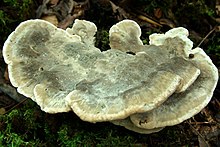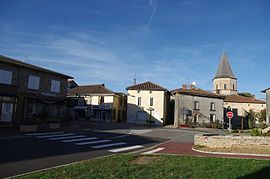티로미케스
Tyromyces| 티로미케스 | |
|---|---|
 | |
| 티로마이오스 치오네우스 | |
| 과학적 분류 | |
| 킹덤: | 곰팡이 |
| 구분: | 바시디오미코타 |
| 클래스: | 아가리코미케스목 |
| 순서: | 다포목 |
| 패밀리: | 폴리포라과 |
| 속: | 티로미케스 P.카르스트 (1881년) |
| 종류종 | |
| 티로마이오스 치오네우스 | |
티로미케스는 폴리포라과과에 속하는 포로이드 균류의 속이다.1881년 균류학자 페터 카스텐에 의해 제한되었다.[1]유형종은 널리 분포된 티로미세스 치오네우스(Tyromyces chioneus)로, 흔히 화이트 치즈 폴리포레로 알려져 있다.[2]폴리포랄레스 내 티로미케스의 계통학적 위치는 불확실하지만, '핵심 폴리포로이드 클라드'에 속하지 않는 것으로 보인다.[3]티로미케스는 현재 제한되어 있는 것처럼 다혈질이고, "벽이 얇은 포자를 가진 모노믹 백로 종을 버리는 장소"[4]로 묘사되어 왔다.
속명은 고대 그리스어 τυός("치즈")와 μύχηη(fungus")[5]에서 유래되었다.
설명
티로마이오스 균류는 과일 몸체를 쌓아 올려 재충전(크러스트 유사)하게 한다.과일 몸체는 수명이 짧고, 대부분 흰색을 띠지만 건조할 때는 더 어두운 색을 띤다.모공 표면의 색은 대개 흰색에서 크림색까지이며, 때로는 녹색을 띤 팅크도 있다.캡 표면처럼 건조하면 어두워진다.[6]
미시적 특성
히팔계통은 단핵계(이 경우 균은 클램프가 있는 생식계 히패만 포함한다) 또는 디미틱계로, 생식계 및 골격계 히패 모두를 포함한다.포자는 매끄럽고 박막하며 히알린(반투명)이다.그것들은 알란토이드(끝이 둥근 긴 길이)에서 난포이드(계란모양)까지 있으며 멜저의 시약과 함께 활성화되지 않는다.히메니움에는 낭포성(hymenium의 표면 너머로 튀어나온 미성숙 기저듐과 직경과 거의 같은 모양의 멸균 세포)가 있을 수 있지만, 히메니움에는 낭포성이 없다.[6]
티로미스는 세계적인 분포를 가진 흰색의 썩은 곰팡이균이다.[6]
종
2016년[update] 9월 현재 펑고룸지수는 타이로미케스의 119종을 수용하고 있다.[7]
- Tyromyces albiformis Quanten(1997) –[8] 파푸아 뉴기니
- 티로미케스알보길부스 (베르크 & 검시관)커티스) 무릴 (1907)
- 티로미케스알보비나케우스 코너(1989)[9]
- 티로미케스 알버스 라이바르덴(2013년)[10]
- Tyromyces alantoideus M.P.그리스도(1960)[11] – 유럽
- 티로미케스 아마루스 (Hedgc.) J.로우(1975)
- 티로미케스 아팔루스 본다르트세프 (1953)
- 티로미케스 아쿠소스 (Henn.) 리바르덴 (2014)[12] – 브라질
- 티로마이케스 아르메니아쿠스 J.D.자오앤엑스큐장(1983)[13] – 중국
- 티로미케스 아트로알버스 (Rick) 라젠브 (1987년)
- 티로미케스 아트로스트리고수스 (코크) 지쿤(1965)
- 티로미케스 오란티쿠스 (코마로바)코마로바 (1964)
- 티로마이오스 아베야네알부스 무릴(1938년)
- 티로미케스 비적분 (Pers.) Bondartsev & Singer (1941)
- 티로미케스 카르보니콜라 구석(1992)
- 티로마이케스 카르파토시쿠스 (필라트 전 필라트) 본다르트세프(1953)
- 티로미케스속 (버크). 지쿤(1965)
- 티로마이오스 치오네우스 (Fr.) P.카르스트 (1881)
- Tyromyces Cinereobrunneus Pitw & Ryvarden(2004)[14] – 에티오피아
- 티로미케스 시나모메포루스 코너(1989)
- 티로미케스 시나모메우스 M마타 & 리바르덴(2010년)[15] – 코스타리카
- 티로미케스 시트리노루스 구석(1992)
- 티로미케스 코르니쿨라투스 코너(1989)
- 티로미케스 코르티콜라 코너(1989)
- 티로미케스 크래시스포루스 Log.-Leite & J.E.라이트(1991년)
- 티로미케스 크리스펠루스 (페크) 무릴 (1907)
- 티로미케스다크리디이 코너(1989)
- 티로미스가 하강하다. 코너(1989)
- 티로미케스디안티콜러 코너(1989)
- Tyromyces duplexus M.마타 & 리바르덴(2010년)[15] – 코스타리카
- 티로미세스 두라시누스 (Pat. 머릴(1907) – 남아메리카
- 티로미체 에베르하르티 (Pat.) 류바르덴(1983)
- 티로미케스 이디오피쿠스 피투앤리바르덴(2004)[14] – 에티오피아
- 티로미케스 엑시구스 (콜렌소) G.쿤. (1965)
- 티로미케스 팔카투스 지쿤(1965)
- 티로미케스 favulus 코너(1989)
- 티로미케스 포모사누스 T.T.창 & W.N.추우(1999년)
- Tyromyces fumidiceps G.F.Atk. (1908)[16] – 북아메리카
- 티로미케스 갈락티누스 (Berk.) J.로위(1975) – 포르투갈
- 티로미케스 길벨루스 (필라트)코마로바 (1964)
- Tyromyces Globosorus Ipulet & Ryvarden(2005)[17] – 아프리카
- 티로미케스 골라니 (마스터) S.아흐마드 (1972년)
- 티로미스가 히스피두리아누스 코너(1989)
- 티로미케스 후메아나 (머릴) J.로우(1975)
- 티로미케스 히알리누스 (베르크). 류바르덴(1980)
- 티로미케스 하이포시트리누스 (베르크). 류바르덴(1984)
- Tyromyces Iludens (Overh. & J.Lowe) J.로우(1975) – New South Wales
- 티로미케스 임브리카투스 J.D.Zhao & X.Q.장 (1983년)
- 투옥된 티로미케스 이마제키 (1954년)
- 티로미케스 이노데르마투스 코너(1989)
- 티로미케스 인터폰스 코너(1989)
- 티로미케스 이르피케우스 코너(1989)
- 티로미케스크메티이 (Bres.) 본다르트세프 & 싱어 (1941)
- Tyromyces latteus (Fr.) Murrill (1907) – 영국
- 티로미케스 나르스누스 코너(1989)
- 티로미케스레우코말루스 (베르크 & 검시관)커티스) 무릴 (1907)
- Tyromyces leucospongia (Cooke & Harkn). Bondartsev & Singer(1941) – 미국
- 티로미케스 레비스 코너(1989)
- 티로미케스 리미타투스 라이바르덴(2000년)[18]
- 티로미케스 라인투스 (오버) J.로우(1975)
- 티로미세스 매그니스포루스 무릴(1940년)
- 티로미케스마리안강 (Bres.) 리바르덴(1988)
- 티로미케스 메디소크라테스 코너(1989)
- 티로미케스 메리티시 무릴(1908)
- Tyromyces Mexicanus Ryvarden & Guzman(2001)[19] – 멕시코
- 티로미케스몰리카세우스 코너(1989)
- 티로미케스 나바로이 M마타 & 리바르덴(2010년)[15] – 코스타리카
- 티로미케스 네모로수스 코너(1989)
- 티로미케스네오스트리고스 라이바르덴 & 이투르르(2003)
- 티로미케스노둘로수스 라이바르덴(2000년)[18]
- 티로미케스오크라시카르네우스속 구석(1992)
- 티로미케스오크라시비노소스속 코너(1989)
- 티로미케스 올리바스켄스 (코너) T.해트. (2003)
- 티로미케스옥시포르아데스 라이바르덴 & 이투르르(2011년)
- 티로미스가 멈췄다. Ipulet & Ryvarden(2005)
- 티로미케스근골격 코너(1989)
- 티로마이케스 핑구스 구석(1992)
- 티로미케스 폴리에테스 파르마스토 (1959년)
- 티로미케스 폴리포르아데스 라이바르덴 & 이투르르(2003)
- 티로미케스 프래굿툴라투스 (머릴) 리바르덴(1985)
- 티로미케스 사이비두스속 본다르트세바 (1970년)[20]
- 티로미케스 사이비회엘리 본다르트세프&코마로바(1959년)
- Tyromyces pulcherrimus (로드웨이) G.Cunn. (1965) – 오스트레일리아
- 티로미케스균류 코너(1989)
- 티로미케스 푸실리카우스 코너(1989)
- 티로미케스푸실러스 (Fr.) G.Cunn. (1965)
- 티로미케스 라둘로이데스 (Henn.) 류바르덴(1980년
- 티로미케스 레티쿨라토마기나투스 (필라트) 본다르트세프 & 싱어 (1941)
- 티로미케스 로도멜론 코너(1989)
- 티로미케스 루브리푸스켄스 코너(1989)
- 티로미케스 루피펜덴스 코너(1989)
- 티로미케스 루피필라투스 코너(1989)
- 티로미케스삼부스속 (로이드) 이마제키(1943)
- 티로미케스사타케이 (이마제키) 콴텐(1997)
- 티로미케스 반밀리미타투스 라이바르덴 & 이투르르(2011년)
- 티로미케스 세티거 (코크) 텡 (1963년)
- 티로미케스 시나피콜러 구석(1992)[21]
- 티로미케스 싱어니 라이바르덴 (1987년)[22]
- 티로마이케스 스콰모셀루스 누녜스&리바르덴(1999년)
- 티로미케스 스콰물로수스 (Bres.) 라이바르덴(1988) – 일본[23]
- 티로마이오스 협착증 코너(1989)
- 티로미케스 아바쿠투스 (머릴) 리바르덴(1985)
- Tyromyces sublacteus M.P.그리스도(1960)[11] – 유럽
- 티로미케스 하위 반지름 코너(1989)
- 티로미케스 아브로시포루스 코너(1989)
- 티로미케스 서브루베센스 코너(1989)
- Tyromyces subviridis Ryvarden & Guzman(2001)[19] – 멕시코
- 황화 티로미케스 코너(1989)
- 티로미케스 테프로노투스 (Berk.) G.Cunn. (1965) – 태즈메이니아
- 티로미세스 테프루스 (Pat.) 류바르덴(1983)
- 티로미케스 경골 J.D.Zhao & X.Q.장 (1983년)
- Tyromyces toatoa G. Tyromyces tooCunn. (1965)[24] – 뉴질랜드
- 티로미케스 트리스타니아아과 코너(1989)
- Tyromyces 처녀자리 Ryvarden & Guzman(2001)[19] – 멕시코
- 티로미케스비텔리누스 라이바르덴 & 하우스클.(2006)[25]
- 티로미케스 비비 호블 전 라이바르덴(2003)
- 티로미세스 슈칠렌시스(Murrill) 리바르덴(1985) – 볼리비아, 중국[26]
- 티로마이오스자메리엔시스 (필라트) 본다르트세프(1953)
참조
- ^ Karsten, P.A. (1881). "Enumeratio Boletinearum et Polyporearum Fennicarum, systemate novo dispositarum". Revue Mycologique Toulouse (in Latin). 3 (9): 16–19.
- ^ Roody, W.R. (2003). Mushrooms of West Virginia and the Central Appalachians. University Press of Kentucky. p. 388. ISBN 978-0-8131-2813-9.
- ^ Binder, Manfred; Justo, Alfredo; Riley, Robert; Salamov, Asaf; Lopez-Giraldez, Francesc; Sjökvist, Elisabet; Copeland, Alex; Foster, Brian; Sun, Hui; Larsson, Ellen; Larsson, Karl-Henrik; Townsend, Jeffrey; Grigoriev, Igor V.; Hibbett, David S. (2013). "Phylogenetic and phylogenomic overview of the Polyporales". Mycologia. 105 (6): 1350–1373. doi:10.3852/13-003. PMID 23935031.
- ^ Miettinen, Otto; Rajchenberg, Mario (2012). "Obba and Sebipora, new polypore genera related to Cinereomyces and Gelatoporia (Polyporales, Basidiomycota)". Mycological Progress. 11 (1): 131–147. doi:10.1007/s11557-010-0736-8.
- ^ Donk, M.A. (1960). "The generic names proposed for Polyporaceae". Persoonia. 1 (2): 173–302.
- ^ a b c Ryvarden, Leif; Melo, Ireneia (2014). Poroid Fungi of Europe. Synopsis Fungorum. Vol. 31. Oslo, Norway: Fungiflora. p. 434. ISBN 978-8290724462.
- ^ Kirk, P.M. "Species Fungorum (version 26th August 2016). In: Species 2000 & ITIS Catalogue of Life". Retrieved 17 September 2016.
- ^ Quanten, E. (1997). "The polypores (Polyporaceae s.l.) of Papua New Guinea. A preliminary conspectus". Opera Botanica Belgica. 11: 1–352.
- ^ Corner, E.J.H. (1989). Ad Polyporaceas V. Beihefte zur Nova Hedwigia. Vol. 96. p. 159.
- ^ Ryvarden, Leif (2012). "Studies in Neotropical polypores 32". Synopsis Fungorum. 30: 33–43.
- ^ a b Christiansen, M.P. (1960). "Danish resupinate fungi. Part II. Homobasidiomycetes". Dansk botanisk Arkiv. 19 (2): 359.
- ^ Ryvarden, Leif (2012). "Type studies in Polyporaceae 27. Species described by P. Ch. Hennings" (PDF). Czech Mycology. 64 (1): 13–31.
- ^ Zhao, J.D.; Zhang, X.Q. (1983). "New species of genus Tyromyces from China". Acta Mycologica Sinica (in Chinese). 2: 18–25.
- ^ a b Bitew, A.; Ryvarden, L. (2004). "Two new Tyromyces species from Ethiopia". Synopsis Fungorum. 18: 80–82.
- ^ a b c Mata, M.; Ryvarden, L. (2010). "Studies in neotropical polypores 27. More new and interesting species from Costa Rica". Synopsis Fungorum. 27: 59–72.
- ^ Atkinson, G.F. (1908). "Notes on some new species of fungi from the United States". Annales Mycologici. 6: 54–62.
- ^ Ipulet, P.; Ryvarden, L. (2005). "The genus Tyromyces in tropical Africa". Synopsis Fungorum. 20: 79–86.
- ^ a b Ryvarden, L. (2000). "Studies in neotropical polypores. 5. New and noteworthy species from Puerto Rico and Virgin Islands". Mycotaxon. 74 (1): 119–129.
- ^ a b c Ryvarden, L; Guzmán, G. (2001). "Studies in neotropical polypores 12. New and noteworthy polypores from Mexico". Mycotaxon. 78: 245–256.
- ^ Bondartseva, M.A. (1969). "Species novae Polyporacearum". Novosti Sistematiki Nizshikh Rastenii. 6: 142–146.
- ^ Corner, E.J.H. (1992). "Additional resupinate non-xanthochroic polypores from Brazil and Malesia". Nova Hedwigia. 55: 119–152.
- ^ Ryvarden, L. (1987). "New and noteworthy polypores from tropical America". Mycotaxon. 28 (2): 525–541.
- ^ Núñez, Maria; Ryvarden, Leif (1999). "New and interesting polypores from Japan" (PDF). Fungal Diversity. 3: 107–121.
- ^ Cunningham, G.H. (1965). "Polyporaceae of New Zealand". Bulletin of the New Zealand Department of Industrial Research. 164: 262.
- ^ Ryvarden, L.; Hausknecht, A.; Krisai-Greilhuber, I. (2006). "Coltricia grandispora and Tyromyces vitellinus, two new polypores". Österreichische Zeitschrift für Pilzkunde. 15: 143–147.
- ^ Zhao, Chang-Lin; Liu, Shi-Liang; Ren, Guang-Juan; Ji, Xiao-Hong; He, Shuanghui (2017). "Three species of wood-decaying fungi in Polyporales new to China". Mycotaxon. 132 (1): 29–42. doi:10.5248/132.29.






